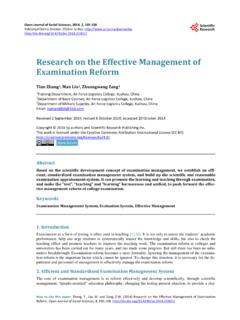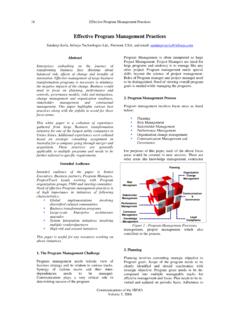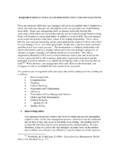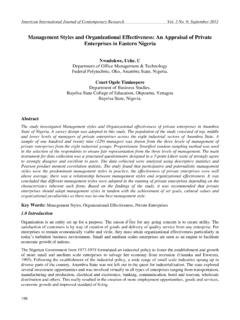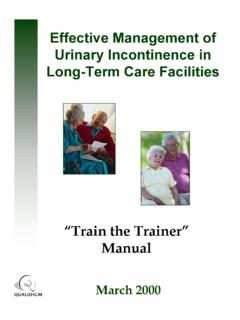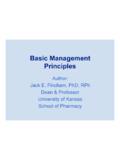Transcription of Effective Management of High-Risk Medicare Populations
1 Effective Management of High-Risk Medicare Populations 1 Effective Management of High-Risk Medicare PopulationsSeptember 2014 Prepared by:Sally Rodriguez, Dianne Munevar, Caitlin Delaney, Lele Yang, Anne TumlinsonAvalere Health LLC Effective Management of High-Risk Medicare Populations 2 TABLE OF CONTENTSE xecutive Summary 3 The Opportunity to Take a More Proactive Stance on Managing Risk 5 Identifying High-Risk Beneficiaries 8 Using Critical Data to Effectively Identify High-Risk Members 11 Opportunity to Enhance the Use of HRAS 14 Background on HRAs 15 Uses of Enhanced HRAs 15 Using HRAs to Support Care Coordination Programs 17 The ROI from Effective Care Coordination Interventions 18 The Promise of Care Coordination Programs 23 Appendix 26 Task 1 Methodology 26 Task 2 Methodology 28 Task 3 Methodology 29 Effective Management of High-Risk Medicare Populations 3 EXECUTIVE SUMMARYIn 2009.
2 The top five percent of Medicare s highest spending beneficiaries represented 39 percent of the program s annual total Fee-for-Service (FFS) These beneficia-ries are typically vulnerable older adults with multiple chronic conditions and functional impairment. A perfect storm of events is driving payers and providers to better manage the cost of this population : dramatic changes in Medicare payment policy; growth in Medicare Advantage (MA) plan enrollment; and the aging of the FFS and MA-enrolled Populations will make it impossible to avoid considerable financial today s market, however, managing health care and by extension, risk typically focuses on treating a person s medical conditions, such as congestive heart failure (CHF) or congestive obstructive pulmonary disease (COPD). However, new Avalere research suggests that an exclusive focus on medical conditions limits a plan s ability to identify and manage spending for the members most likely to incur the highest Medicare costs.
3 In other words, a sizable portion of Medicare spending is attributable to characteristics and behaviors that occur outside of the health care delivery system. To succeed in this era of health system transformation, plans and providers bearing risk in an accountable care organization (ACO), for example will need strategies for managing a broad array of care needs for High-Risk beneficiaries across multiple set-tings of care. Avalere modeling demonstrates the potential for substantial cost savings when transitions across the continuum of care are managed through established care coordination interventions. This new research suggests a three-pronged strategy for managing care, and thereby risk, for High-Risk Populations . Based on this research, we recommend that MA plans and other risk holders: Identify the Right Risk Factors. Non-medical factors are as powerful as medical factors in determining health care utilization.
4 For example, Avalere modeling shows that functional impairment (based on ability to perform activities of daily living, or ADLs), self-reported fair or poor health, and high use of home health care in the prior year increase a Medicare beneficiary s probability of being High-Risk in the subsequent year by approximately 7, 8, and 16 percent, respectively. Therefore, traditional methods of analysis that focus on medical conditions will mask oppor-tunities for intervention. Plans must develop risk profiles using a variety of data sources beyond traditional claims or financial data. These can include health risk assessments (HRAs), medical records, and clinical input; Improve Data Collection through Existing Tools. Through the HRA process, plans have an important opportunity to collect member information that provides risk-identification information, which goes beyond the medical information avail-able in financial data.
5 Typically, MA plans stress easy HRA administration over Effective Management of High-Risk Medicare Populations 4comprehensiveness, but some innovative plans have shown that enhanced HRAs help target appropriate care coordination programs for beneficiaries. Plans should invest further in the HRA process as a conduit for powerful, relevant member information, by adding the key questions necessary to identify future High-Risk beneficiaries; and Implement Targeted Care Coordination Programs. After plans understand the full range of individual factors that contribute to high health care utilization, and identify members at highest risk, they can manage care transitions and support broader care coordination for these members. Effective Management of key Populations not only improves outcomes for plan members, but can yield a positive return on investment (ROI). Avalere s ROI analysis indicates that, for example, the Transitional Care Model, when targeted at High-Risk beneficiaries, can yield an ROI of over 250%.
6 In addition, Avalere found that while some programs have significantly different implementation costs, their effectiveness in impacting key metrics was a significant portion of health care spending can be attributed to non-medical factors, successful population Management strategies require innovative functional- and lifestyle-oriented programming that goes beyond the typical benefits provided by MA plans. New research provides a strong business case for plans and other risk holders to identify the highest risk beneficiaries and target care Management programs that are proven to decrease that risk. Avalere s modeling and resulting ROI calculator demonstrate clear opportunities for bottom line by a grant from The SCAN Foundation advancing a coordinated and easily navigated system of high -quality services for older adults that preserve dignity and Management of High-Risk Medicare Populations 5 THE OPPORTUNITY TO TAKE A MORE PROACTIVE STANCE ON MANAGING RISKA small group of High-Risk beneficiaries account for a disproportionate share of total Medicare spending due to their heavy utilization of costly, often hospital-based care.
7 Until the Affordable Care Act (ACA), FFS providers had little reason to coordinate or manage care for these beneficiaries, much less understand the individual characteristics most likely to result in high health care spending. MA plan enrollment was relatively low ( million in 2008, prior to the passage of the ACAii) and, with a few exceptions, the enrolled population tended to be outside of the highest risk pool of Medicare Far-reaching and dramatic changes in Medicare payment are creating a new health care delivery environment that will reward value over volume. In this value-based delivery system of the future, payers and providers will experience a higher degree of accountability for the health of Populations as well as risk for the cost of episodes or bundles of services that extend across multiple sites of care. As MA enrollment grows, and providers take on risk, they will increasingly serve an older, and likely more complex enrolled population , but with lower payments that are tied to quality.
8 To succeed in this era of health system transformation, provider and insurer organizations will need strategies that go beyond traditional risk mitigation activities ( , enrolling healthier-than-average beneficiaries and negotiating lower provider rates). They will need to proactively identify and manage care for the beneficiaries most at risk of high -cost health care utilization. Active care coordination for High-Risk Populations relies on simple concepts, but the work is hard and extends far beyond traditional disease Management . The challenge that any risk-bearing organization faces in taking on the task of High-Risk care coordination is that little research exists to identify the full range of bio-psycho-social factors that lead to high health care utilization. Research tends to focus narrowly on the medical conditions associated with health care utilization because payers have easy access to health information on the claims providers submit for payment.
9 As a result, most MA plans and provider strategies to identify High-Risk members rely only on claims data analyses, which overlook characteristics critical to care coordination such as lifestyle factors and functional and cognitive impairment. Effective Management of High-Risk Medicare Populations 6 The good news is that a growing body of research is providing additional guidance on the full range of individual characteristics that contribute to high health care spending, and therefore indicate areas for targeted care coordination programs. In particular, recent Avalere research focused on the impact of functional impairment, as a proxy for long-term services and supports (LTSS) need, on health care spending. Functional impairment refers to the inability to perform activities of daily living (ADLs) such as bathing and eating, or instrumental activities of daily living (IADLs), such as using the telephone or managing money, without assistance.
10 Data from a 2011 Avalere and The SCAN Foundation study suggest that when an underlying chronic condition accompanies an inability to care for oneself independently, per capita health care spending can double (Figure 1).iv For example, high health care spending, such as emergency department (ED) visits, may result as much from the risk of falls associated with diabetes as it does the medical complications. $10,133$19,7635 or More Chronic Conditions$7,116$17,3754 Chronic Conditions$5,972$13,2833 Chronic Conditions$4,039$15,4352 Chronic Conditions$2,626$18,2231 Chronic Conditions$5,961$17,498 Any Chronic Conditions Seniors without Functional Impairment Seniors with Functional ImpairmentSource: Avalere Health analysis of the 2006 Medicare Standard Analytic 1: 2006 Per Capita Medicare Spending by Chronic Conditions and Functional Impairment A similar analysis on cognitive impairment (CI) reveals the same relationship.
